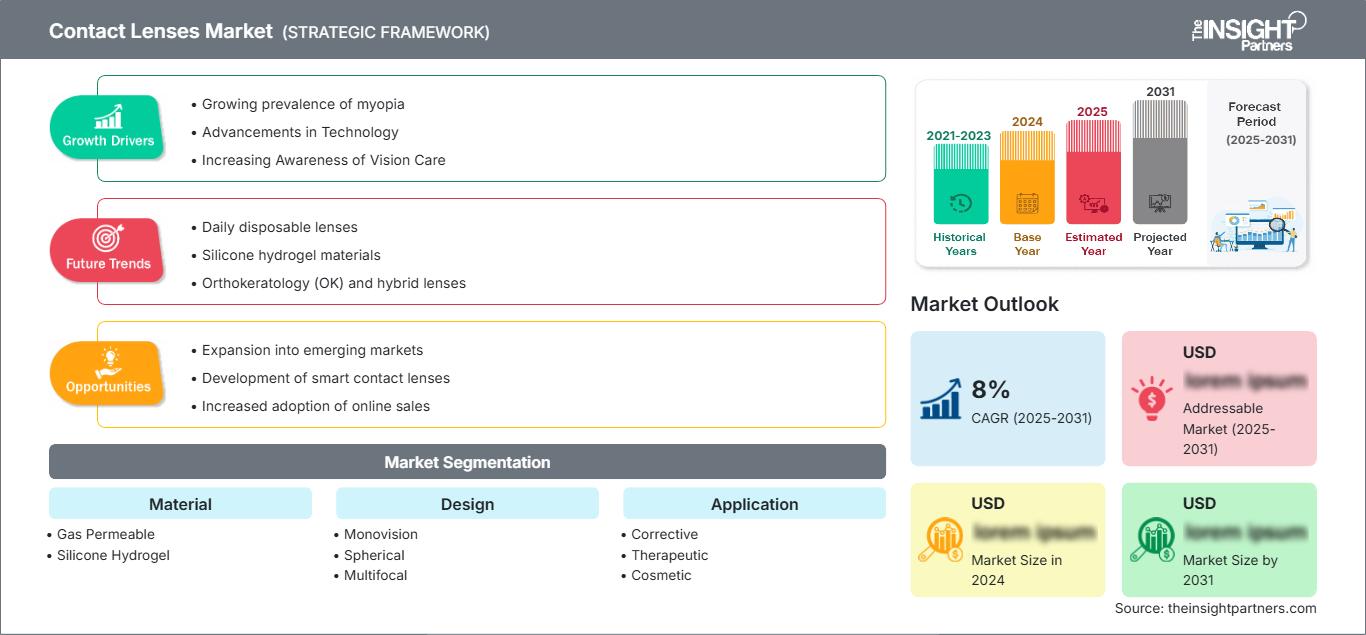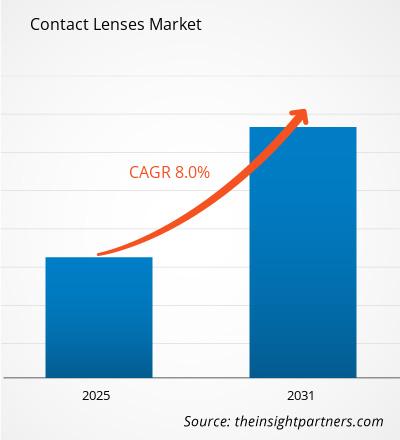Si prevede che il mercato delle lenti a contatto raggiungerà i 25,22 miliardi di dollari entro il 2031. Si prevede che il mercato registrerà un CAGR del 6,1% nel periodo 2025-2031.
Il rapporto è suddiviso in base a materiale (permeabile ai gas, idrogel di silicone e altri), design (monovisione, sferico, multifocale e torico), applicazione (correttiva, terapeutica, cosmetica e altri) e canale di distribuzione (e-commerce, ospedali e cliniche e negozi al dettaglio).
Scopo del rapporto
Il rapporto Contact Lenses Market di The Insight Partners mira a descrivere il panorama attuale e la crescita futura, i principali fattori trainanti, le sfide e le opportunità. Ciò fornirà spunti a vari stakeholder aziendali, come:
- Fornitori/produttori di tecnologia: per comprendere le dinamiche di mercato in evoluzione e conoscere le potenziali opportunità di crescita, consentendo loro di prendere decisioni strategiche informate.
- Investitori: per condurre un'analisi completa delle tendenze in merito al tasso di crescita del mercato, alle proiezioni finanziarie del mercato e alle opportunità esistenti lungo la catena del valore.
- Organismi di regolamentazione: per regolamentare le politiche e le attività di controllo nel mercato con l'obiettivo di ridurre al minimo gli abusi, preservare la fiducia degli investitori e sostenere l'integrità e la stabilità del mercato.
Segmentazione del mercato delle lenti a contatto Materiale
- Gas Permeabile
- Silicone Idrogel
Design
- Monovisione
- Sferica
- Multifocale
- Torica
Applicazione
- Correttiva
- Terapeutica
- Cosmetica
Geografia
- Nord America
- Europa
- Asia-Pacifico
- Sud e Centro America
- Medio Oriente e Africa
Potrai personalizzare gratuitamente qualsiasi rapporto, comprese parti di questo rapporto, o analisi a livello di paese, pacchetto dati Excel, oltre a usufruire di grandi offerte e sconti per start-up e università
Mercato delle lenti a contatto: Approfondimenti strategici

-
Ottieni le principali tendenze chiave del mercato di questo rapporto.Questo campione GRATUITO includerà l'analisi dei dati, che vanno dalle tendenze di mercato alle stime e alle previsioni.
Fattori della crescita del mercato delle lenti a contatto
- Crescente prevalenza della miopia: la miopia elevata, o miopia, è il motore del mercato delle lenti a contatto. Secondo l'Organizzazione Mondiale della Sanità, oltre 1,9 miliardi di persone soffrono di miopia in tutto il mondo e questa cifra aumenterà entro il 2020, raggiungendo i 2,1 miliardi. Con ogni giorno di crescente urbanizzazione e con il trascorrere di più ore in ambienti chiusi, il rischio aumenta, con conseguente aumento della domanda di lenti a contatto.
- Progressi tecnologici: i progressi nella scienza dei materiali hanno portato a lenti a contatto ancora più comode e traspiranti, mentre l'aumento dell'efficienza e la riduzione dei costi grazie al miglioramento dei processi produttivi hanno aumentato la produzione e ridotto i costi. Più recentemente, le lenti a contatto giornaliere usa e getta e i materiali in silicone idrogel hanno ampliato ulteriormente la gamma di opzioni disponibili per i consumatori.
- Crescente consapevolezza della cura della vista: la maggiore consapevolezza della necessità di prendersi cura della vista è il secondo principale motore di crescita del mercato delle lenti a contatto. Poiché i cittadini di un mondo sempre più informato riconoscono la necessità di sottoporsi a visite oculistiche regolari o di trovare altre fonti di cure oculistiche adeguate, molti cittadini optano per le lenti a contatto come alternativa. L'importanza della cura della vista ha anche reso le persone più esigenti riguardo al tipo di lenti di cui hanno bisogno, come le lenti toriche per la correzione dell'astigmatismo o le lenti multifocali per la correzione della presbiopia.
Tendenze future del mercato delle lenti a contatto
- Lenti a contatto giornaliere usa e getta: le lenti a contatto giornaliere stanno diventando molto richieste dal mercato per la loro praticità, igiene e minima irritazione oculare; i consumatori ora cercano questo tipo di prodotti. Il design della lente è tale da toccare l'occhio una sola volta e poi essere gettata via senza bisogno di conservazione o pulizia. Pertanto, per coloro che cercano un'esperienza di utilizzo delle lenti a contatto senza problemi, lo stile di vita sempre più frenetico e attivo le rende più richieste.
- Materiali in silicone idrogel: la recente tendenza nell'uso delle lenti a contatto è rappresentata dai materiali in silicone idrogel, che offrono maggiore comfort, permeabilità all'ossigeno e durata. Questi materiali consentono una maggiore trasmissione di ossigeno agli occhi, riducendo il rischio di irritazione oculare e garantendo un utilizzo più sano. Le lenti in silicone idrogel sono inoltre morbide, flessibili e trattengono l'umidità, caratteristiche comuni a chi utilizza lenti a contatto.
- Lenti ortocheratologiche (OK) e ibride: le lenti ortocheratologiche (OK) e ibride sono le nuove tendenze nel mercato delle lenti a contatto, offrendo comfort ed efficacia come alternativa alle tradizionali lenti RGP. Lenti ortocheratologiche: le lenti ortocheratologiche modellano la cornea durante il sonno, correggendo la vista durante il giorno. I pazienti non devono indossare lenti a contatto. Lenti ibride: le lenti ibride combinano l'essenza delle RGP con una morbidezza che offre una correzione della vista perfetta e comfort. Le lenti OK e ibride stanno guadagnando popolarità tra i portatori, attratti da un modo più pratico, confortevole e pratico di indossare le lenti a contatto.
Opportunità di mercato per le lenti a contatto
- Espansione nei mercati emergenti: il mercato delle lenti a contatto crescerà nei mercati emergenti come Asia-Pacifico, America Latina e Africa, e tale crescita è trainata dall'aumento della popolazione e dalla crescente consapevolezza delle persone sulla necessità di prendersi cura della vista. Le aziende possono sfruttare questa opportunità sviluppando stabilimenti di produzione locali, stringendo partnership con distributori locali e personalizzando i prodotti in base alle preferenze regionali. In questo modo, non solo acquisiscono una quota di mercato maggiore, ma raggiungono anche ogni fascia di popolazione non ancora soddisfatta.
- Sviluppo di lenti a contatto intelligenti: sviluppare lenti a contatto avanzate. Questo offre grandi opportunità di mercato. Un dispositivo di questo tipo potrebbe essere dotato di sensori per il glucosio, microchip o telecamere che fornirebbero alle persone dati in tempo reale sulla salute degli occhi, sulla vista e su altri segnali di vita in anticipo. Tale progresso consentirebbe la trasformazione del modo in cui le persone monitorano e curano le patologie oculari e contribuirebbe a ottimizzare i risultati per i pazienti, migliorando notevolmente l'esperienza d'uso delle lenti a contatto. Le aziende possono avvalersi di alleanze con aziende tecnologicamente avanzate per presentare al mondo prodotti all'avanguardia che uniscano tecnologia e ottica.
- Maggiore adozione delle vendite online: con l'aiuto dell'e-commerce, potrebbe esistere una piattaforma di vendita che incrementerebbe notevolmente le vendite dei produttori di lenti a contatto. È ancora più conveniente, flessibile e conveniente per i consumatori stessi. Le aziende possono sfruttarlo appieno sviluppando siti web accattivanti e offrendo un servizio di abbonamento o collaborando con rivenditori online per raggiungere più clienti, migliorare la soddisfazione del cliente e rimanere al passo con la concorrenza.
Le tendenze regionali e i fattori che influenzano il mercato delle lenti a contatto durante il periodo di previsione sono stati ampiamente spiegati dagli analisti di The Insight Partners. Questa sezione illustra anche i segmenti di mercato e la geografia della gestione delle malattie del ritmo cardiaco in Nord America, Europa, Asia-Pacifico, Medio Oriente e Africa, America meridionale e centrale.
Ambito del rapporto di mercato sulle lenti a contatto
| Attributo del rapporto | Dettagli |
|---|---|
| Dimensioni del mercato in 2024 | US$ XX Billion |
| Dimensioni del mercato per 2031 | US$ 25.22 Billion |
| CAGR globale (2025 - 2031) | 6.1% |
| Dati storici | 2021-2023 |
| Periodo di previsione | 2025-2031 |
| Segmenti coperti |
By Materiale
|
| Regioni e paesi coperti |
Nord America
|
| Leader di mercato e profili aziendali chiave |
|
Densità degli operatori del mercato delle lenti a contatto: comprendere il suo impatto sulle dinamiche aziendali
Il mercato delle lenti a contatto è in rapida crescita, trainato dalla crescente domanda da parte degli utenti finali, dovuta a fattori quali l'evoluzione delle preferenze dei consumatori, i progressi tecnologici e una maggiore consapevolezza dei benefici del prodotto. Con l'aumento della domanda, le aziende stanno ampliando la propria offerta, innovando per soddisfare le esigenze dei consumatori e sfruttando le tendenze emergenti, alimentando ulteriormente la crescita del mercato.

- Ottieni il Mercato delle lenti a contatto Panoramica dei principali attori chiave
Punti di forza
- Copertura completa: il rapporto analizza in modo esaustivo prodotti, servizi, tipologie e utenti finali del mercato delle lenti a contatto, offrendo una panoramica olistica.
- Analisi degli esperti: il rapporto è redatto sulla base della conoscenza approfondita di esperti e analisti del settore.
- Informazioni aggiornate: il rapporto garantisce la pertinenza aziendale grazie alla copertura di informazioni e dati recenti.
- Opzioni di personalizzazione: questo rapporto può essere personalizzato per soddisfare le esigenze specifiche del cliente e adattarsi in modo appropriato alle strategie aziendali.
Il rapporto di ricerca sul mercato delle lenti a contatto può quindi contribuire a guidare il percorso di decodificazione e comprensione dello scenario del settore e delle prospettive di crescita. Sebbene possano esserci alcune valide preoccupazioni, i vantaggi complessivi di questo rapporto tendono a superare gli svantaggi.
- Analisi storica (2 anni), anno base, previsione (7 anni) con CAGR
- Analisi PEST e SWOT
- Valore/volume delle dimensioni del mercato - Globale, Regionale, Nazionale
- Industria e panorama competitivo
- Set di dati Excel
Report recenti
Testimonianze
Motivo dell'acquisto
- Processo decisionale informato
- Comprensione delle dinamiche di mercato
- Analisi competitiva
- Analisi dei clienti
- Previsioni di mercato
- Mitigazione del rischio
- Pianificazione strategica
- Giustificazione degli investimenti
- Identificazione dei mercati emergenti
- Miglioramento delle strategie di marketing
- Aumento dell'efficienza operativa
- Allineamento alle tendenze normative






















 Ottieni un campione gratuito per - Mercato delle lenti a contatto
Ottieni un campione gratuito per - Mercato delle lenti a contatto